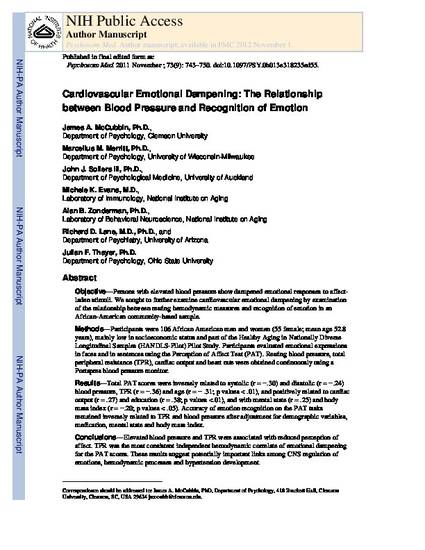
Article
Cardiovascular Emotional Dampening: The Relationship between Blood Pressure and Recognition of Emotion
Psychosomatic Medicine
Document Type
Article
Publication Date
11-1-2011
Publisher
Lippincott, Williams & Wilkins
Disciplines
Abstract
Objective—Persons with elevated blood pressure show dampened emotional responses to affectladen stimuli. We sought to further examine cardiovascular emotional dampening by examination of the relationship between resting hemodynamic measures and recognition of emotion in an African-American community-based sample.
Methods—Participants were 106 African American men and women (55 female; mean age 52.8 years), mainly low in socioeconomic status and part of the Healthy Aging in Nationally Diverse Longitudinal Samples (HANDLS-Pilot) Pilot Study. Participants evaluated emotional expressions in faces and in sentences using the Perception of Affect Test (PAT). Resting blood pressure, total peripheral resistance (TPR), cardiac output and heart rate were obtained continuously using a Portapres blood pressure monitor.
Results—Total PAT scores were inversely related to systolic (r = −.30) and diastolic (r = −.24) blood pressure, TPR (r = −.36) and age (r = − .31; p values < .01), and positively related to cardiac output (r = .27) and education (r = .38; p values <.01), and with mental state (r = .25) and body mass index (r = −.20; p values < .05). Accuracy of emotion recognition on the PAT tasks remained inversely related to TPR and blood pressure after adjustment for demographic variables, medication, mental state and body mass index.
Conclusions—Elevated blood pressure and TPR were associated with reduced perception of affect. TPR was the most consistent independent hemodynamic correlate of emotional dampening for the PAT scores. These results suggest potentially important links among CNS regulation of emotions, hemodynamic processes and hypertension development.
Citation Information
Please use publisher's recommended citation.

This manuscript has been published in Psychosomatic Medicine Journal of Biobehavioral Medicine. Please find the published version here (note that a subscription is necessary to access this version):
http://journals.lww.com/psychosomaticmedicine/pages/articleviewer.aspx?year=2011&issue=11000&article=00005&type=abstract